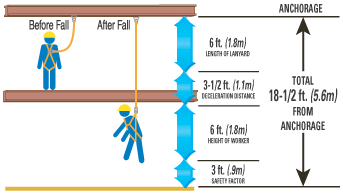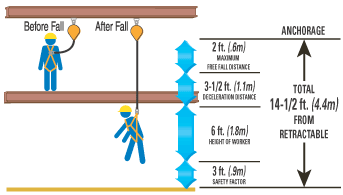Fall Distance Diagram with calculations. Calculating Fall Clearance Distance:°Using a Shock-Absorbing Lanyard and D-Ring Anchorage Connector• First, add the length of the shock-absorbing lanyard (6 ft.) to the maximum elongation of the shock absorber during deceleration (3-1/2 ft.) to the average height of a worker (6 ft.). • Then, add a safety factor of 3 ft. to allow for the possibility of an improperly fit harness, a taller than average worker and/or a miscalculation of distance. • The total, 18-1/2 ft. is the suggested safe fall clearance distance for this example. † NOTE: Should the shock-absorbing lanyard be used in conjunction with a cross-arm anchorage connector or other, the additional length of the anchorage connector must be taken into consideration.  Calculating Fall Clearance Distance: °Using a Retractable Lifeline• First, add the maximum free fall distance (2 ft.) with a retractable lifeline to the maximum deceleration distance (3-1/2 ft.) to the average height of a worker (6 ft.). • Then, add a safety factor of 3 ft. to allow for the possibility of an improperly fit harness, a taller than average worker and/or a miscalculation of distance. • The total, 14-1/2 ft. is the suggested safe fall clearance distance for this example. † NOTE: When using a retractable lifeline, the distance is calculated from the point where the retractable attaches to the back D-ring of the worker’s harness. ‡ Information provided by osha.gov |






